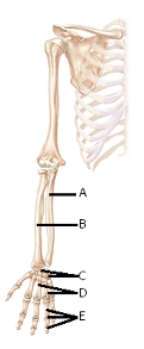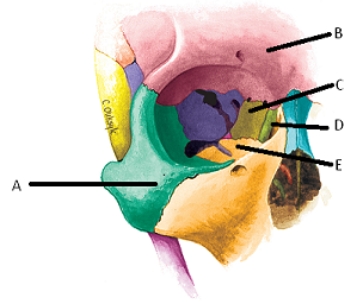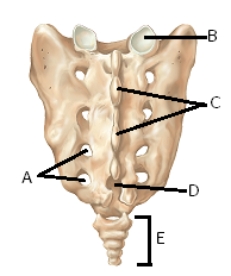A) absent in humans.
B) also called the coxa.
C) located in the upper lumbar region.
D) the most inferior portion of the vertebral column.
E) the bottom of the spinal cord.
G) None of the above
Correct Answer

verified
Correct Answer
verified
Multiple Choice
 -The figure illustrates bones of the right upper limb.What does "A" represent?
-The figure illustrates bones of the right upper limb.What does "A" represent?
A) radius
B) carpals
C) phalanges
D) metacarpals
E) ulna
G) A) and E)
Correct Answer

verified
Correct Answer
verified
Multiple Choice
John Flashback was running downfield with the football.As he tried to avoid a tackle,he stepped in a hole and his foot was twisted under him with great force.The X-ray shows a "broken ankle".The structure that is most likely broken is the
A) calcaneus bone.
B) the patella.
C) a bone in the second metatarsal.
D) the lateral malleolus.
E) the medial cuneiform.
G) A) and D)
Correct Answer

verified
Correct Answer
verified
Multiple Choice
The frontal bone is known as the
A) collar bone.
B) elbow.
C) tail bone.
D) hip bone.
E) forehead.
G) B) and C)
Correct Answer

verified
Correct Answer
verified
Multiple Choice
What results from damage to annulus fibrosus and release of nucleus pulposus?
A) lordosis
B) kyphosis
C) scoliosis
D) spina bifida
E) herniated disk
G) None of the above
Correct Answer

verified
Correct Answer
verified
Multiple Choice
The loss of height that occurs with aging is due to compression of the
A) pelvic girdle.
B) vertebral arches.
C) vertebral bodies.
D) vertebral foramen.
E) intervertebral discs.
G) B) and E)
Correct Answer

verified
Correct Answer
verified
Multiple Choice
The fibrocartilage located between the bodies of adjacent vertebrae is the
A) intervertebral disk.
B) vertebral foramen.
C) lamina.
D) intervertebral foramen.
E) spinous process.
G) B) and E)
Correct Answer

verified
Correct Answer
verified
Multiple Choice
Which of the following facial bones is correctly matched with its function?
A) temporal - is part of the orbit.
B) inferior nasal conchae - contain nasolacrimal canals
C) vomer - forms the hard palate
D) zygomatic - provides attachment point for temporalis muscle
E) maxilla - possesses sockets for teeth
G) A) and C)
Correct Answer

verified
Correct Answer
verified
Multiple Choice
 -The figure shows the bones of the right orbit.What bone does "B" represent?
-The figure shows the bones of the right orbit.What bone does "B" represent?
A) frontal
B) maxilla
C) zygomatic
D) lacrimal
E) ethmoid
G) A) and B)
Correct Answer

verified
Correct Answer
verified
Multiple Choice
The common name for the patella is the
A) zygomatic bone.
B) finger bones.
C) kneecap.
D) breastbone.
E) shinbone.
G) D) and E)
Correct Answer

verified
Correct Answer
verified
Multiple Choice
The common name for the phalanges is the
A) zygomatic bone.
B) finger bones.
C) kneecap.
D) breastbone.
E) shinbone.
G) C) and E)
Correct Answer

verified
Correct Answer
verified
Multiple Choice
Ribs that do not attach directly to the sternum are called _____ ribs.
A) false
B) vertebral
C) vertebrosternal
D) vertebrochondral
E) floating
G) A) and C)
Correct Answer

verified
Correct Answer
verified
Multiple Choice
The posterior part of the vertebral arch is the
A) intervertebral disk.
B) vertebral foramen.
C) lamina.
D) intervertebral foramen.
E) spinous process.
G) B) and D)
Correct Answer

verified
Correct Answer
verified
Multiple Choice
The posterior,inferior projection from vertebrae is the
A) intervertebral disk.
B) vertebral foramen.
C) lamina.
D) intervertebral foramen.
E) spinous process.
G) None of the above
Correct Answer

verified
Correct Answer
verified
Multiple Choice
 -The figure illustrates the sacrum.What structure does "D" represent?
-The figure illustrates the sacrum.What structure does "D" represent?
A) coccyx
B) sacral hiatus
C) superior articular facet
D) median sacral crest
E) posterior sacral foramina
G) A) and B)
Correct Answer

verified
Correct Answer
verified
Multiple Choice
Jill,an avid runner,experiences pain on her greater trochanter.Where is Jill's pain located?
A) distal fibula
B) posterior scapula
C) posterior knee
D) heel
E) lateral femur
G) C) and D)
Correct Answer

verified
Correct Answer
verified
Multiple Choice
What canal conveys tears from the eyes to the nasal cavity?
A) jugular foramen
B) carotid canal
C) external auditory canal
D) nasolacrimal canal
E) foramen ovale
G) C) and E)
Correct Answer

verified
Correct Answer
verified
Multiple Choice
This condition is also known as hump back.
A) lordosis
B) kyphosis
C) scoliosis
D) spina bifida
E) herniated disk
G) A) and B)
Correct Answer

verified
Correct Answer
verified
Multiple Choice
Which skull canal does the internal carotid artery pass through?
A) nasolacrimal canal
B) external auditory canal
C) jugular foramen
D) carotid canal
E) foramen ovale
G) A) and C)
Correct Answer

verified
Correct Answer
verified
Multiple Choice
What condition is the failure of vertebral laminae to fuse?
A) lordosis
B) kyphosis
C) scoliosis
D) spina bifida
E) herniated disk
G) C) and D)
Correct Answer

verified
Correct Answer
verified
Showing 81 - 100 of 173
Related Exams